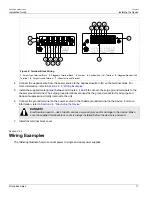
RUGGEDCOM RX1000P
Installation Guide
Chapter 3
Communication Ports
GPS Antenna
25
The following sections describe each component in the GPS antenna system in more detail:
•
Section 3.7.3.1, “GPS Antenna”
•
Section 3.7.3.2, “Antenna Cabling”
•
Section 3.7.3.3, “Lightning Considerations”
•
Section 3.7.3.4, “Line Amplification and Filtering”
Section 3.7.3.1
GPS Antenna
There are two major types of GPS antenna: passive and active. A passive antenna requires no power and is
an option when signal strength is not a concern. An active antenna has a built in Low Noise Amplifier (LNA)
to increase the strength of the signal, and to compensate for the signal loss in a long cable connection. Active
antennas are used when the antenna input is connected to the receiver through a coaxial cable (usually longer
than 3 m) or any high loss transmission path.
NOTE
• The PTP card’s GPS input provides 5 VDC at up to 10 mA to power the antenna.
• Best results can be achieved with a total gain of 16 dB (includes antenna gain, cable loss, lightning
arrestor loss, line amplifier gain and filter loss) at the antenna input.
The PTP Card requires an active antenna with the following specifications:
Characteristic
Active Antenna
Polarization
Right-Hand Circular Polarized
Receive Frequency
1.57542 GHz ± 1.023 MHz
Power Supply
5 VDC
DC Current
< 10 mA at 3 VDC
Antenna Gain
Select antenna gain based on system configuration
Total Gain at PTP GPS Input (includes antenna gain, cable
loss, lightning arrestor loss, line amplifier gain and filter loss)
Total Gain ≤ 18 dBi
Axial Ratio
< 3 dB
Output VSWR
< 2.5
Section 3.7.3.2
Antenna Cabling
Cable Impedance:
Siemens recommends low loss 50 Ω coaxial cabling.
Cable Delay:
Using any length of coaxial cable will add some time delay to the GPS signal which degrades
the accuracy of the calculated time and position. The time delay is dependent on the type of dielectric material
in the cable and ranges from 1 to 2 ns/ft. Siemens provides a method to account for this delay through the
web management interface by entering the time delay into the cable compensation box under PTP General
Configuration. The table below gives some examples of the delay that can be expected based on the dielectric
type.
















































